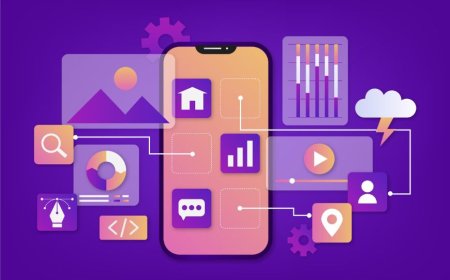The Evolution of Android: A Complete History
Tectoks presents the ultimate guide to the evolution of Android. Explore the complete history of this revolutionary operating system with just one click.

Table of Contents:
-
Introduction
-
The Early Beginnings
-
Historical Progression of Android
-
Evolutionary Stages of Android
-
Android Version History
-
Android Software Upgrades
-
Advancements in Android Technology
-
Impact on the Tech Industry
-
Conclusion
1. Introduction
The introduction of the Android operating system has had a huge impact on the world of technology. Since its inception, Android has revolutionized the way we interact with mobile devices, making it an integral part of our daily lives. Understanding the definition, importance, and evolution of Android is crucial to grasping its profound impact on the tech world.
Definition of Android OS:
Android is an open-source operating system primarily designed for touchscreen mobile devices such as smartphones and tablets. It was developed by Google and has a user-friendly interface, supports a large range of programs, and allows for customization, making it one of the most popular operating systems worldwide.
Importance of Android in the Tech World:
Android's significance in the tech world is immense due to several reasons:
-
Market Dominance: Android holds the largest share of the global smartphone market. Its versatility, availability across various device manufacturers, and adaptability to different hardware configurations have contributed to its widespread adoption.
-
App Ecosystem: The Google Play Store, Android's official app marketplace, boasts millions of applications catering to diverse user needs. This extensive app ecosystem has fueled innovation and productivity across different industries.
-
Customization and Open-Source Nature: Android's open-source nature encourages innovation and allows developers to modify the system according to their preferences. This flexibility has led to a vibrant community of developers who are constantly improving and creating new functionalities for the OS.
-
Integration with Other Technologies: Android's integration with other Google services like Gmail, Google Drive, and Maps enhances user experience and promotes seamless connectivity across devices.
Evolution of Android:
The evolution of Android OS can be traced back to 2003, when a company called Android Inc. was founded by Andy Rubin and others to develop a mobile operating system. In 2005, Google acquired Android Inc. and continued the operating system's development. The first public beta of Android OS was released in 2007, followed by the first commercial version, Android 1.0, in 2008. Since then, Android OS has gone through many major updates and releases, each with a different name and version number. Some of the notable releases include:
-
Android 1.5 Cupcake (2009): The first release to have a dessert-themed name and to introduce an on-screen keyboard, widgets, and video recording.
-
Android 2.0 Eclair (2009): The release that added voice-guided navigation, multiple accounts, and live wallpapers
-
Android 2.2 Froyo (2010): The release improved the performance and speed of the operating system, as well as adding support for Adobe Flash and tethering.
-
Android 4.0 Ice Cream Sandwich (2011): The release unified the design and user experience of Android OS across different devices and introduced features such as face unlock, data usage control, and Android Beam.
-
Android 4.4 KitKat (2013): The release that optimized the operating system for low-end devices and added features such as Google Now, cloud printing, and immersive mode.
-
Android 5.0 Lollipop (2014): The release introduced a new design language called Material Design and added features such as notification enhancements, battery saver mode, and multiple user profiles.
-
Android 6.0 Marshmallow (2015): The release improved the security and privacy of the operating system and added features such as Google Now on Tap, fingerprint authentication, and Doze mode.
-
Android 7.0 Nougat (2016): The release enhanced the multitasking and productivity of the operating system and added features such as split-screen mode, quick settings, and picture-in-picture mode
-
Android 8.0 Oreo (2017): The release improved the performance and battery life of the operating system and added features such as notification dots, autofill, and smart text selection.
-
Android 9 Pie (2018): The release that introduced a new gesture-based navigation system and added features such as adaptive battery, digital wellbeing, and app actions
-
Android 10 (2019): The first release to use a numerical name instead of a dessert-themed name, and added features such as dark mode, privacy controls, and gesture navigation.
-
Android 11 (2020): The release focused on improving the communication and media experience of the operating system and added features such as chat bubbles, screen recorders, and smart device controls.
-
Android 12 (2021): The release that introduced a new design system called Material You and added features such as color extraction, privacy dashboard, and one-handed mode
-
Android 13 (2022): The release enhanced the security and accessibility of the operating system and added features such as face detection, scrolling screenshots, and app hibernation
-
Android 14 (2023): The latest release of Android OS, which improved the performance and stability of the operating system and added features such as live translation, app pairs, and game mode.
2. The Early Beginnings
Google created the Android OS mobile operating system, which is mostly meant to be utilized with touchscreen gadgets, such as tablets and smartphones. It is based on a modified version of the Linux kernel and other open-source software, and it allows users to access a variety of Google services and apps, as well as millions of other applications from the Google Play Store. Android OS is the most widely used mobile operating system in the world, with a market share of over 70% as of 2023.
Origins of Android OS
The story of Android OS can be traced back to 2003, when a company called Android Inc. was founded by Andy Rubin and others to develop a mobile operating system. Initially, Android OS was intended to improve the operating systems of digital cameras, but the market for stand-alone digital cameras was declining, so the company shifted its focus to mobile phones.
Andy Rubin and the founding of Android Inc.
Andy Rubin is an American computer programmer, entrepreneur, and venture capitalist. He has a passion for robots and was nicknamed “Android” by his co-workers at Apple in 1989. He later worked for General Magic and Danger Inc., where he helped create the Danger Hiptop, one of the first proto-smartphones In 2003, he co-founded Android Inc. with Rich Miner, Nick Sears, and Chris White in Palo Alto, California. The company’s goal was to create an open-source operating system for mobile devices that would be more aware of its owner’s location and preferences.
Acquisition by Google: A turning point for Android
In 2005, Android Inc. was running low on funds and needed investors to continue its development. Google saw the potential of the company and its product and decided to acquire Android Inc. for around $50 million. On July 11, 2005, the Android team relocated to Google's Mountain View, California, headquarters. That day is regarded as the official date for Google's acquisition of Android. However, the news that Google had purchased Android did not become public until a few weeks later, in August 2005.
Under Google’s ownership, the Android team continued to work on the operating system, with Rubin as the leader. They also collaborated with other Google engineers and services, such as Google Maps, Gmail, and YouTube. They also partnered with hardware manufacturers, such as HTC, Samsung, and Motorola, to create devices that would run Android OS. The first public beta of Android OS was released in 2007, followed by the first commercial version, Android 1.0, in 2008.
The acquisition of Android by Google was a turning point for both the company and the mobile industry. It enabled Google to enter the smartphone market and compete with other players, such as Apple, Microsoft, and Nokia. It also gave the Android OS a huge boost in terms of resources, exposure, and distribution. It also paved the way for the creation and innovation of many mobile devices and applications that cater to the different needs and preferences of users. Android OS became the most popular and influential mobile operating system in the world and changed the way people communicate, access information, and entertain themselves.
3. Historical Progression of Android
The historical progression of Android can be summarized as follows:
-
Android Beta: Early testing phases This was the first public release of the Android mobile operating system, which was developed by Google and based on a modified version of the Linux kernel and other open-source software. The beta version was released on November 5, 2007, and the software development kit (SDK) was released on November 12, 2007. The beta version was tested on software emulators, as physical devices did not exist at that time. The beta version and the SDK were released, along with their source code, as free software under the Apache License
-
Android 1.0 to 1.5 (Cupcake): Initial versions and features The first commercial version of Android, Android 1.0, was released on September 23, 2008, along with the first Android device, the T-Mobile G1 (also known as HTC Dream) Android 1.0 and 1.1 did not have any codenames, but Android 1.5, released on April 27, 2009, was the first version to have a dessert-themed name: Cupcake Cupcake introduced many improvements to the Android interface, such as the first on-screen keyboard, widgets, and video recording. It also included a suite of Google apps, such as Gmail, Maps, Calendar, and YouTube, that were integrated into the operating system.
-
Android 1.6 to 2.3 (Gingerbread): expansion and user interface improvements Android 1.6, codenamed Donut, was released on September 15, 2009. It added support for different screen sizes and resolutions, as well as CDMA networks like Verizon. It also introduced the universal search box, which allowed users to search the web and the device from the home screen Android 2.0 to 2.1, codenamed Eclair, was released on October 27, 2009. It was the first Android version to enter mainstream consciousness, thanks to the Motorola Droid phone and the Verizon marketing campaign. It also added voice-guided turn-by-turn navigation, multiple accounts, and live wallpapers Android 2.2, codenamed Froyo, was released on May 20, 2010. It improved the performance and speed of the operating system, as well as adding support for Adobe Flash and tethering. Android 2.3, codenamed Gingerbread, was released on December 6, 2010. It refined the user interface, making it simpler and faster. It also added support for near-field communication (NFC), SIP VoIP, and new audio effects
During this phase, Android experienced substantial growth in terms of both features and market adoption. The continuous updates and improvements in each iteration laid the groundwork for Android to evolve into a more robust, feature-rich, and user-friendly operating system. These versions set the stage for further advancements, cementing Android's position as a formidable player in the mobile operating system arena.
4. Evolutionary Stages of Android
Android is a mobile operating system that has evolved over the years, adding new features and improvements to enhance the user experience and performance. Here are some of the major evolutionary stages of Android:
-
Android 3.0 to 4.1 (Honeycomb to Jelly Bean): Tablet optimization and smoother interface This stage marked the transition of Android from a phone-centric operating system to a versatile platform that can run on different device classes, especially tablets. Android 3.0 Honeycomb introduced a new user interface design called Holo, which was optimized for larger screens and had a futuristic look. Honeycomb also added support for hardware acceleration, USB host mode, and an action bar. Android 4.0 Ice Cream Sandwich unified the design and user experience of Android across phones and tablets and introduced features such as face unlock, data usage control, and Android Beam. Android 4.1 Jelly Bean improved the performance and smoothness of the operating system with Project Butter, which implemented triple buffering, vsync timing, and touch responsiveness. Jelly Bean also added features such as expandable notifications, Google Now, and offline voice typing.
-
Android 4.4 to 5.1 (KitKat to Lollipop): Material Design and Enhanced User Experience This stage focused on improving the aesthetics and usability of Android, as well as optimizing it for low-end devices and emerging markets. Android 4.4 KitKat reduced the memory footprint of the operating system, making it run faster and smoother on devices with as little as 512 MB of RAM. KitKat also added features such as Google Now Launcher, cloud printing, and immersive mode. Android 5.0 Lollipop introduced a new design language called Material Design, which gave Android a more colorful, flat, and consistent look. Lollipop also added features such as notification enhancements, battery-saver mode, and multiple user profiles.
-
Android 6.0 to 7.1 (Marshmallow to Nougat): Focus on performance and multitasking. This stage aimed to improve the security, privacy, and efficiency of Android, as well as enhance its multitasking capabilities. Android 6.0 Marshmallow improved the permission system, allowing users to grant or deny permissions to apps at runtime rather than at installation time. Marshmallow also added features such as Google Now on Tap, fingerprint authentication, and Doze mode. Android 7.0 Nougat enhanced the multitasking and productivity of Android by adding features such as split-screen mode, quick settings, and picture-in-picture mode. Nougat also added support for the Vulkan API, which enabled high-performance 3D graphics on Android devices.
5. Android Version History
Android 8.0 to 9.0 (Oreo to Pie): AI Integration and Adaptive Features:
-
Android 8.0-8.1 (Oreo, 2017): Oreo brought several enhancements, including picture-in-picture mode, notification channels, and Project Treble for streamlined updates. It also introduced AI-powered features like Smart Text Selection, which used machine learning to suggest appropriate actions based on selected text.
-
Android 9.0 (Pie, 2018): Pie expanded AI integration with Adaptive Battery, which used machine learning to prioritize battery power for apps frequently used by the user. It also introduced adaptive brightness, which adjusts screen brightness based on user preferences to provide a more personalized and efficient user experience.
- Android 10 to 12: Privacy Enhancements and Gesture Navigation:Android 10 (2019): Android 10 emphasized user privacy with features like enhanced location permissions, a dedicated privacy section in settings, and the introduction of a system-wide dark mode. It also brought gesture-based navigation for smoother interaction and control over app permissions.
-
Android 11 (2020): Building upon privacy enhancements, Android 11 introduced one-time permission grants, chat bubble notifications, and improved media controls. It refined gesture navigation and emphasized communication and device control enhancements.
-
Android 12 (2021): Android 12 focused on visual and user experience enhancements with Material You, allowing extensive theming and customization options. It introduced more responsive animations, redesigned widgets, and privacy indicators to notify users when apps access the camera or microphone. The update aimed to create a more personalized and visually appealing user interface.
- Android 13 and Beyond: The Latest Features and Future Directions:Future Directions: While the specifics of Android 13 and beyond aren't fully known at this time, ongoing trends suggest a continued emphasis on privacy, user-centric design, and seamless device interoperability. Future versions are expected to refine privacy controls, potentially offering more granular permissions and security enhancements.
Additionally, advancements in AI integration, improved power efficiency, and sustainability efforts might play key roles in shaping future Android updates. Features enhancing the user experience, bolstering security, and adapting to the evolving technological landscape are likely to be focal points in upcoming iterations of Android.
6. Android Software Upgrades
Android software upgrades are important for the performance, security, and functionality of your device. However, they also pose some challenges and impact the user experience. Here is a brief explanation of these aspects:
Challenges of Software Fragmentation:
Software fragmentation refers to the diversity of Android versions running on devices at any given time. This happens due to various factors, such as different manufacturers, customized user interfaces (UIs), and carrier interventions. As a result, there's a vast array of devices running different versions of Android concurrently, creating challenges for developers, users, and the ecosystem as a whole. It leads to difficulties in ensuring consistent app compatibility, timely updates, and uniform user experiences across devices.
Importance of Timely Updates for Security and Features:
Timely software updates are crucial for both security and feature enhancements. Security vulnerabilities are continuously discovered in operating systems, and prompt updates are essential to patch these vulnerabilities and protect devices from potential threats like malware, hacking, and data breaches. Furthermore, updates often introduce new features, performance improvements, and optimizations that enhance the overall user experience and functionality of the device.
User Experience: Impact of Software Upgrades on Devices
Software upgrades significantly impact the user experience in several ways:
-
Security: Up-to-date software ensures that devices have the latest security patches, reducing the risk of security breaches and data compromises.
-
Performance: Updates often include optimizations and bug fixes that can improve device performance, such as faster app launches, smoother multitasking, and better battery life.
-
Features: New features and functionalities introduced through updates can enhance the device's capabilities, offering users access to improved tools, services, and user interfaces.
-
Compatibility: Apps are frequently updated to leverage new OS features, and running an outdated OS may hinder app compatibility or access to certain functionalities.
However, software upgrades can also pose challenges. Older devices might not receive updates due to hardware limitations or discontinued support from manufacturers, leading to a fragmented user experience. Additionally, some updates might introduce bugs or performance issues, impacting user satisfaction.
To update your Android device, you need to check the availability of updates, download and install them, and restart your device. The exact steps may vary depending on your device, manufacturer, and carrier, but you can generally follow these instructions:
-
Connect to Wi-Fi and keep your phone charged.
-
Open the Settings app
-
Scroll down and tap System
-
Tap System update
-
Tap Check for update
-
Tap Download and install
-
If prompted, select Restart now
-
Wait for Android to finish updating after restarting.
Overall, while software upgrades bring significant benefits, ensuring timely and consistent updates across a diverse range of devices remains a challenge in the Android ecosystem. Balancing security, features, and compatibility while maintaining a smooth user experience across devices of varying ages and capabilities is an ongoing effort within the Android community.
7. Advancements in Android Technology
Advancements in Android technology are the result of continuous innovation and improvement in hardware and software integration, artificial intelligence and machine learning, and IoT and smart devices. Here is a quick description of each of these areas:
-
Hardware and software integration: This refers to the process of designing and developing Android devices that have optimal performance, compatibility, and user experience. It involves using the latest chips, sensors, connectivity modules, and security features to enable Android devices to run various applications and services smoothly and securely. For example, Android devices use computational photography, which combines hardware and software to produce high-quality images and videos. Another example is the use of virtual prototypes, which allow Android developers to test and debug their hardware and software designs before manufacturing.
-
Artificial intelligence and machine learning: This refers to the use of advanced algorithms and models to enable Android devices to learn from data, recognize patterns, and perform tasks that require human intelligence. It involves using neural networks, natural language processing, knowledge representation, and expert systems to enhance the functionality and usability of Android devices.
For example, Android devices use AI and ML to power features such as Google Assistant, Google Photos, adaptive battery, smart reply, and live captioning. Another example is the use of AI and ML to enable digital transformation, which is the process of using technology to improve business processes and customer experiences.
-
IoT and smart devices: This refers to the use of Android devices to connect and interact with other devices, sensors, and systems over the internet. It involves using wireless technologies, cloud services, and edge computing to enable Android devices to collect, process, and exchange data with other devices and platforms. For example, Android devices use IoT and smart devices to enable features such as smart home automation, smart health monitoring, smart manufacturing, and smart transportation. Another example is the use of IoT and smart devices to enable hyper-automation, which is the process of applying AI and ML to automate and optimize tasks that used to be done by humans
Impact on the Tech Industry
Impact on the Tech Industry Android’s market dominance and its influence Competition and collaboration in the Android ecosystem prospects and innovations in Android technology
Here is a summary of the impact of Android on the tech industry, based on the topics you have provided:
-
Android’s market dominance and its influence: Android is the most widely used operating system for smartphones, tablets, and other smart devices, with over 2.5 billion active users worldwide. Android has a significant influence on the tech industry, as it enables developers, manufacturers, and consumers to access a variety of applications, services, and features that enhance the functionality and usability of devices. Android also fosters innovation and competition in the mobile market, as it offers an open and flexible platform that can be customized and adapted to different needs and preferences. Android also contributes to the digital transformation of various sectors, such as education, health, entertainment, and commerce, by providing solutions that leverage artificial intelligence, machine learning, cloud computing, and IoT.
-
Competition and collaboration in the Android ecosystem: The Android ecosystem consists of multiple stakeholders, such as Google, device makers, app developers, and users, who interact and cooperate to create value and deliver products and services. The Android ecosystem also faces competition from other ecosystems, such as Apple’s iOS, which has a loyal and affluent customer base and a closed and integrated platform. The competition between Android and iOS has led to both platforms improving their quality, performance, and security, as well as offering new features and functionalities to attract and retain users. However, the competition also poses some challenges, such as fragmentation, compatibility, and interoperability issues, as well as potential antitrust and regulatory concerns.
-
Prospects and innovations in Android technology: Android technology is constantly evolving and improving as it adopts new trends and technologies that enhance the user experience and address the emerging needs and demands of the market. Some of the prospects and innovations in Android technology include:
-
Android Instant Apps: These are native apps that run instantly without requiring installation, allowing users to try out apps before downloading them. This technology improves the app discovery and engagement process, as well as reducing the storage and data usage of devices.
-
Blockchain Technology: This is a decentralized and distributed ledger system that enables secure and transparent transactions and data sharing. Android apps can leverage blockchain technology to provide solutions for various domains, such as finance, health, education, and social media, that require trust, privacy, and security.
-
Machine Learning and Artificial Intelligence: These advanced algorithms and models enable devices to learn from data, recognize patterns, and perform tasks that require human intelligence. Android apps can use machine learning and artificial intelligence to power features such as voice assistants, image recognition, natural language processing, and recommendation systems that enhance the functionality and usability of devices.
-
Multiplatform Development: This is the process of developing apps that can run on multiple platforms, such as Android, iOS, and the web, with a single codebase. Android apps can use frameworks such as Flutter, which is a cross-platform framework developed by Google, to create beautiful and fast apps that can reach a wider audience and reduce development costs and time.
8. Conclusion
Summary of Android's Transformative Journey:
Android's journey began with a vision to create an adaptable and intuitive operating system for mobile devices. From its inception to its current status as a dominant force in the tech industry, Android has undergone remarkable evolution. It started as an open-source project, was acquired by Google, and has since grown into a versatile platform powering a myriad of devices globally.
The evolution of Android has seen numerous iterations, each bringing enhancements, innovations, and refinements. From fundamental features like the notification bar to advancements in AI integration, security measures, and the expansion of IoT devices, Android has continually adapted to meet changing user needs and technological advancements.
Reflection on Impact and Significance:
Android's evolution has profoundly impacted the tech industry and user experiences. Its market dominance, extensive app ecosystem, and versatility have reshaped how people interact with technology. Android's influence extends beyond smartphones, influencing the development of wearables, smart devices, and various IoT applications.
The significance of Android lies in its democratization of technology, making powerful and feature-rich devices accessible to a broad spectrum of users. It has fostered innovation, competition, and collaboration within the tech ecosystem, driving advancements and enhancing user experiences.
Looking Ahead: The Continual Evolution of Android OS
As we look to the future, Android's evolution continues. The platform is poised to further integrate AI and machine learning, enhance privacy and security measures, and explore new frontiers in device form factors and connectivity.
The ongoing evolution of Android promises continued innovation, bringing forth advancements that will shape the way we interact with devices and access information. Android's journey, marked by adaptability, innovation, and user-centric design, remains on a trajectory of continual evolution, aiming to meet the evolving needs of users and the ever-changing technological landscape.
In conclusion, Android's transformative journey, impact on the tech industry, and commitment to evolution highlight its enduring significance in shaping the future of technology and user experiences.
What's Your Reaction?











































































